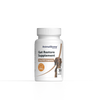Hip dysplasia also known as developmental dysplasia of the hip (DDH), is a condition where a dog’s hip joint doesn’t develop the way it’s supposed to. This can cause problems with how the joint works, leading to pain and arthritis over time. It’s especially common in larger breeds, but it can affect dogs of any size.

Hip dysplasia in dogs is caused by a mix of genetics and environmental factors. Certain breeds, like German Shepherds, Labradors, and Golden Retrievers, are genetically predisposed, especially if their parents had hip issues. A Swiss study (1995–2016) showed selective breeding reduced hip dysplasia significantly, dropping cases in Golden Retrievers from 25% to 9%, in Labradors from 16% to 3%, and in German Shepherds from 46% to 18%. Environmental factors also play a role, including rapid growth, poor nutrition, excess weight, and inappropriate exercise.
Warning Signs of Hip Dysplasia in Dogs
Hip dysplasia can cause your dog a lot of discomfort and make it hard for them to move around. Knowing the signs early can help you manage the condition and keep your dog as comfortable as possible. Here are some things to watch out for:
-
Trouble Standing, Running, or Climbing Stairs
One of the first things you might notice is your dog struggling with everyday movements. They may hesitate to climb stairs, seem slower when getting up from the floor, or avoid running like they used to.
-
Limping or Walking Unevenly
Does your dog seem to favor one leg or walk with a bit of a limp? This could be a sign that their hips are bothering them, especially if the limp is in their back legs.
-
A “Bunny-Hopping” Run
Sometimes dogs with hip dysplasia will run in a way where both back legs move together, almost like a bunny hopping. It’s their way of avoiding putting too much strain on their hips.
-
Less Energy or Reluctance to Play
If your normally playful pup seems to lose interest in running, jumping, or playing, hip pain might be the cause. A dog in discomfort is less likely to enjoy the activities they once loved.
-
Stiffness or Sensitivity Around the Hips
Pay attention to how your dog reacts when you touch their hips. If they seem stiff, flinch, or look uncomfortable, it might mean their hips are inflamed or painful.

Natural Ways to Manage Hip Dysplasia in Dogs
For many dogs, non-surgical care is enough to manage hip dysplasia and keep them comfortable. These options are focused on easing pain, improving mobility, and protecting the joints:
Healthy Weight and Best Food for Dog with Hip Dysplasia
Maintaining a healthy weight is crucial for minimizing stress on your dog’s hips. Feeding a balanced diet tailored to their needs supports overall health and joint function. A study by Kasström (1975) showed that puppies fed high-calorie diets were more likely to develop hip dysplasia, and it often started earlier and was more severe. A balanced diet can help your dog grow at a healthy rate and keep their joints strong.
If you’re looking for the best food for hip dysplasia in dogs, The Original Crockpet Diet is a great choice. It uses simple, wholesome ingredients and avoids the fillers and empty calories you find in many commercial pet foods. With this diet, you’re in control of your dog’s meals, helping them maintain a healthy weight and avoid extra strain on their joints.
Joint Supplements
Joint supplements, such as glucosamine, chondroitin, and omega-3 fatty acids, can help reduce inflammation and support joint health. While they don’t cure hip dysplasia, consistent use can slow progression and improve comfort. Studies show these supplements reduce pain, improve movement, and ease arthritis symptoms over time. Compared to prescription medications, they are gentler on your dog’s system and suitable for long-term use.
Pain Management
Your veterinarian may recommend NSAIDs to alleviate pain and inflammation. Alternative therapies like acupuncture and massage can also provide relief. Research by Teixeira et al. (2016) demonstrated acupuncture's ability to reduce chronic pain and lameness in dogs with hip dysplasia, improving their mobility and quality of life.
Physical Therapy and Hydrotherapy
Low-impact exercises and hydrotherapy strengthen the muscles around the hips and improve mobility. Hydrotherapy, using an underwater treadmill, provides a joint-friendly workout while soothing sore muscles and joints with warm water.
By combining these approaches, you can help your dog stay active, comfortable, and happy despite hip dysplasia.
What Can You Do if Your Dog Has Hip Dysplasia?
If your dog has hip dysplasia, making adjustments to their daily routine and environment can go a long way in improving their comfort:
-
Use Supportive Tools: Ramps or steps can make it easier for your dog to get on the couch, into the car, or up stairs without straining their hips. Orthopedic beds provide extra support for aching joints.
-
Adjust Exercise Routines: Gentle, low-impact activities like short walks or swimming can help keep your dog active without putting too much stress on their hips.
Creating a Supportive Home Environment
You can make small changes at home to keep your dog comfortable:
-
Keep their favorite spots easy to access with ramps or padded surfaces.
-
Place non-slip mats or rugs in areas where your dog frequently walks, lies down, or gets up. These provide extra grip and stability, making it easier for them to stand up or lie down without slipping.
-
Keep their weight under control with healthy meals and snacks.
Final Thought
Hip dysplasia can be a challenging condition, but it doesn’t mean your dog can’t live a happy and fulfilling life. With early detection, the right care, and a proactive approach, you can make a significant difference in your dog’s comfort and mobility. From feeding a balanced diet and avoiding overexercise during puppyhood to incorporating joint supplements, pain management strategies, and supportive tools, there are many ways to help your furry friend thrive.
If your dog is already living with hip dysplasia, remember that small adjustments to their environment, like ramps, non-slip mats, and orthopedic beds, can go a long way in improving their quality of life. Regular vet check-ups are also essential for monitoring their condition and making adjustments to their treatment plan as needed.
















